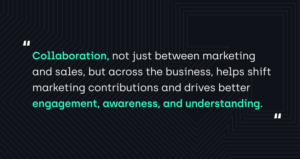Marketing is constantly evolving with new technologies and resources that force us to focus on continued innovation. Add to that changing buyer preferences and new generations of buyers, and it becomes instantly clear that a marketer’s success depends on their ability to quickly and effectively adapt to change. In this spirit of change, here are 5 transformative mindset shifts to consider for the year ahead that will keep you out front.
1. Shift From Product-Centric to Customer-Centric
Becoming customer-centric involves a fundamental change in your marketing. Instead of focusing on the features and attributes of your products, you will prioritize the needs, preferences, and experiences of the customer. In doing this, you will build your marketing strategies around creating value for customers and fostering long-term relationships instead of simply promoting products.
This includes moving away from one-size-fits-all marketing approaches to personalized strategies that leverage data and technology to tailor messages and experiences based on individual preferences and behaviors. To do this effectively, you will want to prioritize customer feedback and incorporate learnings across the business, including product development and management, customer service, and, of course, marketing.
Placing the customer at the center of your marketing efforts can lead to increased customer loyalty, advocacy, and long-term success in the market.
2. Shift From Short-Term Wins to Long-Term Value
Everyone is looking for quick wins, right? While perceived gains such as a bump in website traffic, asset downloads, or social media followers can look good in your reporting, without a correlation to business value, the negative impact can be significant. Poor return on marketing investment and loss of confidence in your marketing efforts can change how your company perceives marketing, resulting in lower levels of investment or shifts in budgets.
As a marketing leader, prioritize strategies that focus on targeted right-fit audiences and invest in building brand awareness and generating leads that will result in shifting your ideal prospects into ideal customers. This approach is more about thoughtful and tailored communications based on data and insights, and will require patience for it to pay off. If your organization has gotten used to big numbers from marketing, you will likely need to clearly communicate the change in strategy and the overall value, as well as reset expectations from what marketing will deliver and in what timeframe.
Additionally, focused marketing efforts designed for customer retention should be part of your strategy and not simply left to sales or customer service. Satisfied and loyal customers are more likely to make repeat purchases, stay engaged with the brand, and become advocates, contributing to sustained revenue over time. Retaining existing customers and maximizing their lifetime value reduces the need for heavy investments in constant customer acquisition, as loyal customers are more cost-effective to retain than acquiring new ones.
3. Shift From Promoting to Storytelling
Incorporating storytelling into your marketing adds a human dimension to your brand, products, or services. While it can be more challenging and requires more effort than simply promoting product features or functions, compelling narratives resonate with customers and create emotional connections that are not only memorable but often inspire action.
Stories are naturally engaging and can capture your audience’s attention more effectively than straightforward information or promotion. Incorporating characters, conflicts, and resolutions into your marketing can create a compelling experience that draws people in and creates community. And, when information is presented in narrative form, it’s easier for people to remember and recall, reinforcing the brand in their minds while providing the opportunity to differentiate your value.
Whether delivered through written content, videos, social media posts, or other formats, your stories can be tailored to fit different platforms and audience preferences while leaving a lasting impression that can surprise, educate, inspire, or entertain.
4. Shift From Silos to Collaboration
Have you ever heard this?
When revenue goals are met, it’s because of Sales. When revenue goals are missed, it’s because of Marketing.
This thinking has no place in today’s organizations – it marginalizes the role of marketing and creates animosity between marketing and sales. Collaboration, not just between marketing and sales, but across the business, helps shift marketing contributions and drives better engagement, awareness, and understanding. It is crucial in marketing for several reasons and contributes to the overall effectiveness and success of marketing efforts.

Encouraging communication and collaboration about your company’s marketing efforts across different departments and roles enables diverse skills and perspectives to contribute to marketing initiatives. Recognize the value of cross-functional teams and promote a culture that shifts from a fear of failure to embracing innovation and calculated risks. Teams with diverse perspectives can implement collaborative goal-setting, joint brainstorming sessions, and regular cross-team meetings to discuss ideas, challenge assumptions, and come up with innovative solutions that may not be possible in siloed working conditions.
When teams work together to gather insights from various sources and departments, both inside and outside the organization, we gain a more holistic view that can result in better marketing efforts and stronger outcomes. Plus, team members who feel part of a collaborative effort are more likely to be motivated, innovative, and committed to achieving collective goals.
5. Shift From Attention to Intention
From the C-Suite perspective, marketing is measured by its contribution to the bottom line. While marketing efforts that drive awareness are necessary for effective lead generation, it’s essential that your strategy doesn’t end with likes, clicks, and followers. Shifting from a focus of attracting attention to engaging buyers with intention reflects a strategic move towards understanding and aligning with the genuine interests and needs of your target audience to drive the kind of engagement that positively impacts the business.
Intention-based marketing focuses on attracting an audience with a genuine interest in your product or service by using data insights including browsing history, page views and time on page, as well assessing them as a good customer prospect . Quality leads are more likely to convert and contribute to long-term business success, as opposed to a large but less engaged audience. Getting very clear on your Ideal Customer Profile (ICP) and using this to guide your outbound efforts—as well as filter your inbound opportunities—is the best place to start. This focus increases the likelihood of higher conversion rates, as your marketing efforts are directed towards those with a clear intent to engage or purchase. Leveraging buyer intent data is relevant here, but not everyone searching for a solution you offer will be a good sales prospect for your company.
Understanding the drivers of your audience allows you to tailor your marketing messages and experiences to meet their specific needs. Personalized and relevant content improves the overall customer experience, fostering a stronger connection with your brand. Focusing on driving attention typically leads to marketing fatigue, where audiences become disinterested or annoyed with repetitive and irrelevant content. Shifting from attention to intention in marketing allows for a more strategic and customer-centric approach that can lead to higher-quality leads and enhanced customer relationships.
Are You Ready to Shift Your Marketing Mindset?
Adopting these mindset shifts can position marketers to thrive in the ever-evolving landscape of modern marketing, fostering adaptability, innovation, and customer-centricity. If you would like guidance or support to make some of these changes, we’re here to help.
Yeager also provides turnkey solutions to the most common marketing challenges faced by B2B Technology companies. Built from a best practice, “what works” perspective and informed from hundreds of projects with leading technology companies, check out our solutions for content, brand, demand gen and research here.

